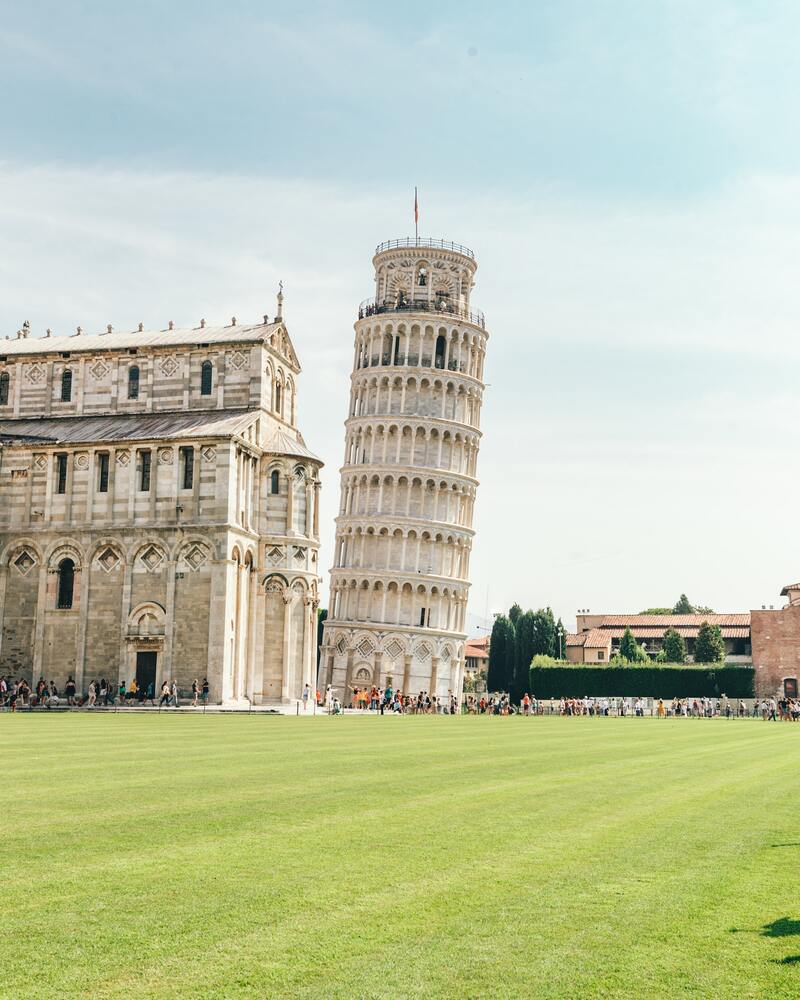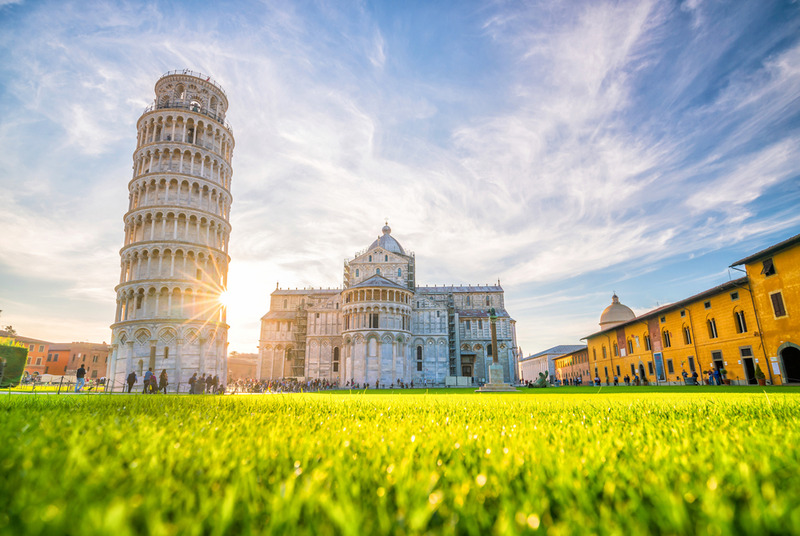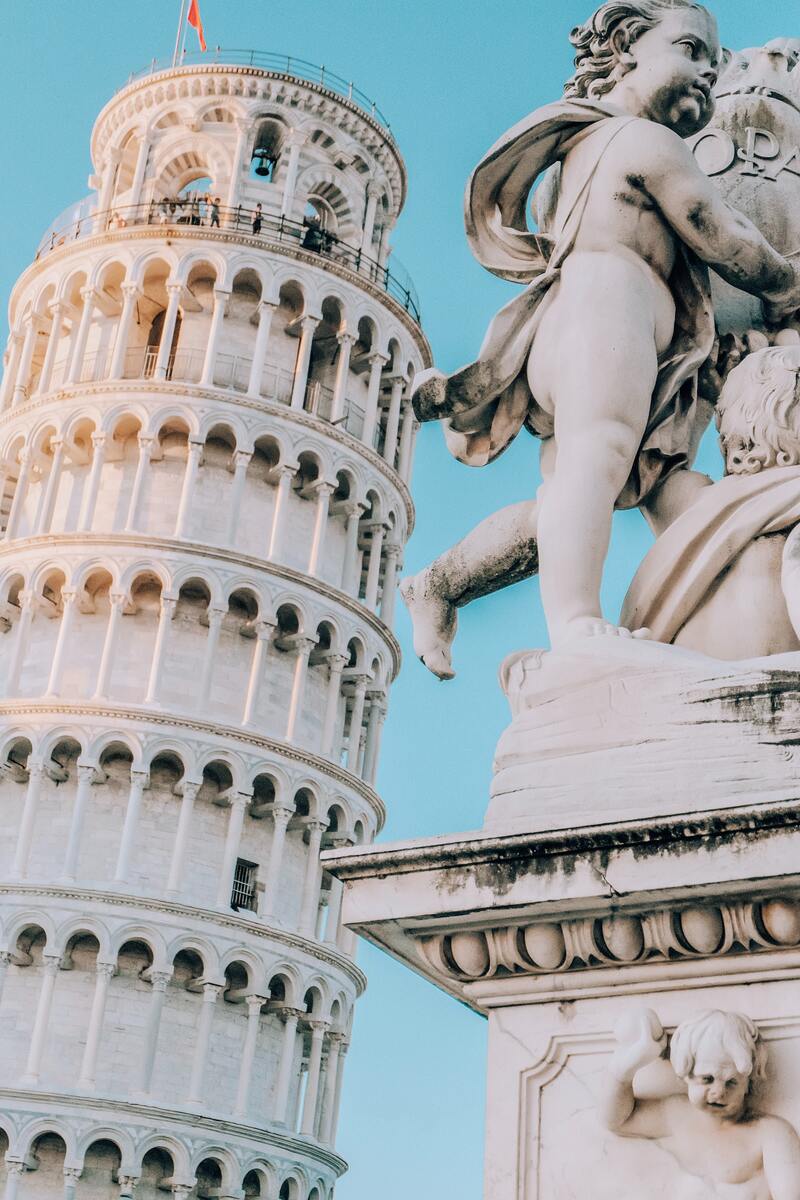Italy is a country you cannot miss on a European tour. It boasts rich cultural heritage and numerous renowned destinations that attract many travel enthusiasts. One of the most famous tourist spots in Italy is the Leaning Tower of Pisa. What makes the Leaning Tower of Pisa so special that it draws countless visitors? Let’s explore this with the travel guide Gomsubaoloc!
Italy, with its diverse cultural landmarks and historic sites, offers a wealth of experiences for travelers. Among its many attractions, the Leaning Tower of Pisa stands out as a unique and intriguing site.
The Leaning Tower of Pisa, known for its unintended tilt, is a remarkable architectural phenomenon. Constructed in the 12th century as the freestanding bell tower for the cathedral of the city of Pisa, it began to lean during construction due to unstable foundation soil. Despite numerous efforts to correct its tilt, the tower continues to lean, making it an iconic symbol of human ingenuity and perseverance.
The tower’s tilt, which measures about 4 degrees, creates a fascinating visual effect, capturing the curiosity and imagination of visitors from around the world. The structure itself, made of white and grey marble, features a series of arches and columns that reflect the Romanesque architectural style. Climbing the 294 steps to the top offers breathtaking views of the surrounding Piazza dei Miracoli, also known as the Square of Miracles.
Beyond its architectural wonder, the Leaning Tower of Pisa is part of a larger complex that includes the Cathedral of Pisa, the Baptistery, and the Camposanto Monumentale. These structures collectively form a UNESCO World Heritage site, offering a deeper insight into medieval Italian art and architecture.
The Leaning Tower of Pisa also holds a special place in scientific history. It is famously associated with Galileo Galilei, who is said to have conducted experiments on gravity from the tower. This connection adds an element of scientific intrigue to its already rich historical significance.
Visiting the Leaning Tower of Pisa is not just about witnessing its unique tilt. It is about immersing yourself in a place where history, art, and science converge. The tower, despite its structural anomaly, stands as a testament to the resilience and creativity of its builders.
In conclusion, Italy is a treasure trove of cultural and historical marvels, with the Leaning Tower of Pisa being a standout attraction. Its unique lean, historical significance, and architectural beauty make it a must-visit destination for any traveler exploring Europe. Embrace the opportunity to experience this iconic landmark and the rich history it represents.
- Leaning Tower of Pisa – Unique architectural work only found in Italy
1.1. Where is the Leaning Tower of Pisa?
The Leaning Tower of Pisa (also known as the Pisa Bell Tower) is an incredibly famous attraction that many travel enthusiasts seek out when exploring beautiful Italy.
Located in the city of Pisa, Italy, this tower was constructed in the 12th century and is an integral part of the Piazza dei Miracoli (Square of Miracles) complex.
The Leaning Tower of Pisa began construction in 1173 and took nearly two centuries to complete. The prolonged construction period was due to interruptions caused by wars between Italian city-states. These interruptions lasted for almost a century. It was not until 1372 that the Leaning Tower of Pisa was finally completed and put into use.
The tower stands 56.67 meters high on the south side and 55.86 meters on the north side. It comprises eight stories, with 294 steps leading to the top. Its distinctive feature is the tilt of 5.5 degrees from the vertical, measured in the 20th century. After numerous efforts to alter and reinforce it, the tower’s tilt has been reduced to less than 4 degrees today.
The Leaning Tower of Pisa is more than just an architectural marvel; it is a symbol of resilience and history. The tower’s construction began with a solid foundation, but due to the unstable soil beneath, it started to lean as early as the third story. Despite this flaw, the construction continued, and the result is a structure that captivates millions of visitors each year.
Climbing the 294 steps to the top of the tower offers a unique experience, providing panoramic views of the Piazza dei Miracoli. The complex itself includes other significant buildings such as the Cathedral of Pisa, the Baptistery, and the Camposanto Monumentale. Each of these structures showcases the artistic and architectural achievements of medieval Italy.
The Leaning Tower of Pisa also holds a notable place in the history of science. It is famously linked to the experiments of Galileo Galilei, who supposedly dropped two spheres of different masses from the tower to demonstrate that their descent was independent of their mass, contributing to the foundation of physics as we understand it today.
Visiting the Leaning Tower of Pisa allows you to step into a space where history, science, and art intersect. The tower’s tilt, once seen as a critical flaw, has become its most celebrated feature, attracting curiosity and admiration from around the globe. Its current tilt of less than 4 degrees stands as a testament to modern engineering efforts to preserve this historical wonder.
In conclusion, the Leaning Tower of Pisa is not just a must-see landmark in Italy, but a profound representation of historical persistence and architectural ingenuity. Its unique lean, coupled with its rich history and cultural significance, makes it an essential destination for any traveler exploring Italy. Embrace the chance to witness this iconic structure and delve into the stories it holds.

1.2 Why is the Tower of Pisa leaning?
The Leaning Tower of Pisa has a distinctive tilt that piques the curiosity of many travelers, prompting them to wonder how it could lean so much. The answer lies in the unique geographical characteristics of the city of Pisa. Pisa’s soft soil, primarily composed of mud, clay, and sand, is the primary reason for the tower’s lean.
The second cause of the tower’s lean is its insufficient foundation. Despite the tower’s total weight of 14,000 tons, its foundation is only about 3 meters deep and made from a dense clay mixture.
In 1934, during Benito Mussolini’s rule in Italy, engineers attempted to stabilize and repair the tower by pouring concrete into its foundation. However, this intervention did not improve the situation and even increased the tower’s tilt.
Interestingly, many researchers believe that the same soft soil that caused the tower to lean has also played a crucial role in its survival through earthquakes and other natural disasters. According to scientific calculations, the Leaning Tower of Pisa will not lean any further and is expected to remain stable for at least the next 200 years.
The Leaning Tower of Pisa, known for its remarkable inclination, draws attention due to the intriguing reasons behind its tilt. The soft soil of Pisa, with its composition of mud, clay, and sand, provides a less stable foundation, leading to the tower’s lean. This characteristic soil could not support the heavy structure, causing the gradual tilt.
Additionally, the inadequate foundation exacerbated the tilt. The shallow 3-meter foundation, insufficient to support the massive 14,000-ton structure, contributed significantly to its leaning. Despite several attempts to correct this, including Mussolini’s concrete injection in 1934, the tower’s lean persisted, even increasing slightly.
Fascinatingly, the very softness of the soil that caused the initial lean has also contributed to the tower’s resilience. It is believed that this soft foundation has absorbed and mitigated the effects of seismic activity, preventing the tower from collapsing during earthquakes. This paradoxical situation, where the cause of instability also provides a measure of protection, adds to the tower’s unique charm.
According to scientific studies, the Leaning Tower of Pisa’s current tilt is stable and unlikely to worsen. Advanced engineering interventions over the years have ensured its safety, and experts predict that it will remain secure for at least another two centuries. This stability allows visitors to continue marveling at this architectural wonder without fear of its collapse.
The Leaning Tower of Pisa is more than just a tilted structure; it is a testament to the complexities of engineering and the surprises of natural geology. Its lean, once seen as a flaw, has become its defining feature, attracting millions of visitors who marvel at its endurance and unique history.
In conclusion, the Leaning Tower of Pisa owes its famous tilt to the soft, unstable soil of Pisa and its inadequate foundation. Despite numerous efforts to correct its lean, the tower remains tilted but stable, with the very factors causing its lean also contributing to its survival. This iconic landmark stands as a symbol of architectural ingenuity and the unexpected interplay between human construction and natural forces. Its continued stability ensures that it will remain a must-visit destination for years to come, offering a fascinating glimpse into the challenges and triumphs of historical engineering.
1.3 Ticket price to visit the Leaning Tower of Pisa
The ticket prices for visiting the Leaning Tower of Pisa include two basic options:
Combo Tickets:
- Full Combo Ticket: This includes access to all the attractions within the Piazza dei Miracoli complex, such as the Leaning Tower, the Baptistery, the Cathedral, the Cemetery, and two museums. This ticket costs 27 euros.
- Partial Combo Ticket: This includes access to the Baptistery, the Cathedral, the Cemetery, and two museums, but not the Leaning Tower. This ticket costs 10 euros. If you plan to visit the Leaning Tower along with other attractions, the first option is recommended.
Single Tickets:
- Leaning Tower and Cathedral: This ticket costs 20 euros.
Important Notes When Buying Tickets for the Leaning Tower of Pisa:
- Exterior Viewing: If you only want to check out the tower from the outside and do not plan to go inside, you do not need to buy a ticket.
- Ticket Booths and Online Booking: The ticket booths at the Leaning Tower of Pisa can be quite crowded. It is advisable to book tickets online in advance to save waiting time.
- Age Restrictions: Children under 8 years old are not allowed to climb the Leaning Tower. Children aged 8 to 18 must be accompanied by an adult.
- Visitor Limitations: The Leaning Tower of Pisa has restrictions on the number of visitors and the duration of each visit. Only 30 people are allowed to climb the tower at a time, and each visit is limited to 30 minutes.
Visiting Tips:
- Planning Ahead: Given the high demand and the limited number of visitors allowed at a time, planning your visit in advance is essential. Booking tickets online can save you significant waiting time.
- Accompanying Children: If you’re traveling with children, ensure they meet the age requirements and that you can accompany them if necessary.
- Maximizing Your Visit: To make the most of your visit, consider purchasing the full combo ticket, which allows you to explore all major attractions in the Piazza dei Miracoli. This will provide a comprehensive experience of the historical and architectural wonders of Pisa.
The Leaning Tower of Pisa is not just an architectural marvel but also part of a larger historical complex that includes the Cathedral, the Baptistery, the Cemetery, and museums. By understanding the ticket options and planning accordingly, you can enhance your visit and ensure a smooth and enriching experience at this iconic landmark.

- Instructions for traveling when traveling to the Leaning Tower of Pisa
To reach the Leaning Tower of Pisa, you need to make your way to the city of Pisa. Here are some methods compiled by MIA.vn to help you find your way to Pisa:
By Plane:
- Galileo Galilei International Airport: You can land at this airport in Pisa. However, flying is recommended only if Pisa is your first or last destination in your itinerary for exploring Italy.
By Bus:
- Bus Services: You can take a bus from other cities to Pisa Centrale station.
By Train:
- Pisa Centrale Station: If you travel by train, you can arrive at Pisa Centrale station and then proceed to the Leaning Tower of Pisa. Trains typically depart from major cities such as Florence or Cinque Terre.
Additional Travel Tips:
- From the Airport: Once you land at Galileo Galilei International Airport, you can take a bus, taxi, or train to Pisa Centrale station. The airport is well connected, and the journey to the city center is quick and convenient.
- From Pisa Centrale: The Leaning Tower of Pisa is approximately a 20-minute walk from Pisa Centrale station. You can also take a local bus or taxi if you prefer not to walk.
- Tickets and Schedules: It is advisable to check the train and bus schedules in advance to plan your trip efficiently. Booking tickets online can also save time and ensure you get a seat, especially during peak travel seasons.
Reaching the Leaning Tower of Pisa is straightforward with these transportation options. Whether you choose to fly, take a bus, or travel by train, the city of Pisa is well connected and easy to navigate, ensuring a smooth journey to this iconic landmark.

- Which season should you visit the Leaning Tower of Pisa?
The city of Pisa becomes especially beautiful and picturesque during the fall season. You can explore the Leaning Tower of Pisa and its nearby attractions from mid-September to mid-December. During this period, the weather is pleasantly cool, making it ideal for sightseeing and taking photos. The mild chill in the air adds a charming touch to your visit, allowing you to enjoy the landmarks without the intense heat of summer.
